#art philosophy
Text
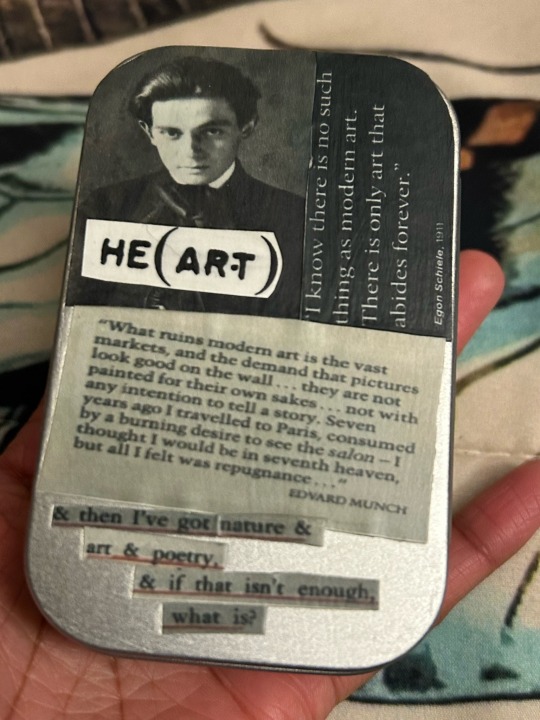
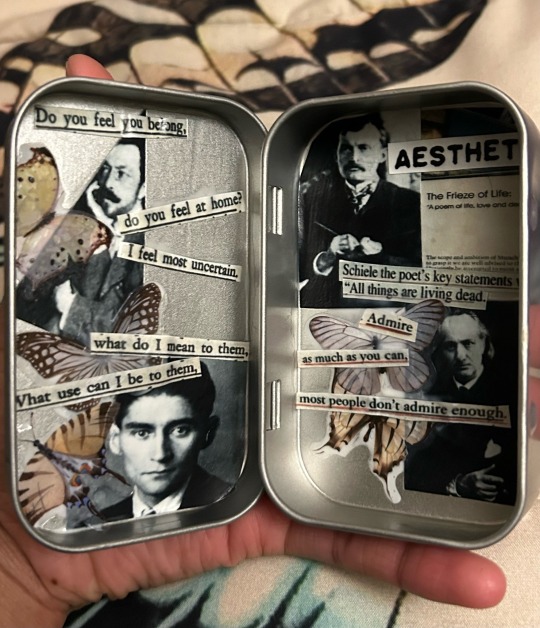

I could no longer resist the urge to make an altoid tin shrine for my inspirations. It long feels overdue
#egon schiele#edvard munch#charles baudelaire#wassily kandinsky#franz kafka#vincent van gogh#decadence#decadence philosophy#art theory#art philosophy#art psychology#existentialism#against nature#Karl Huysmans#altoid shrine#my art#dark acamedia#light acamedia#art history#art academia
86 notes
·
View notes
Text
wowo Nietzsche wanna be #byme
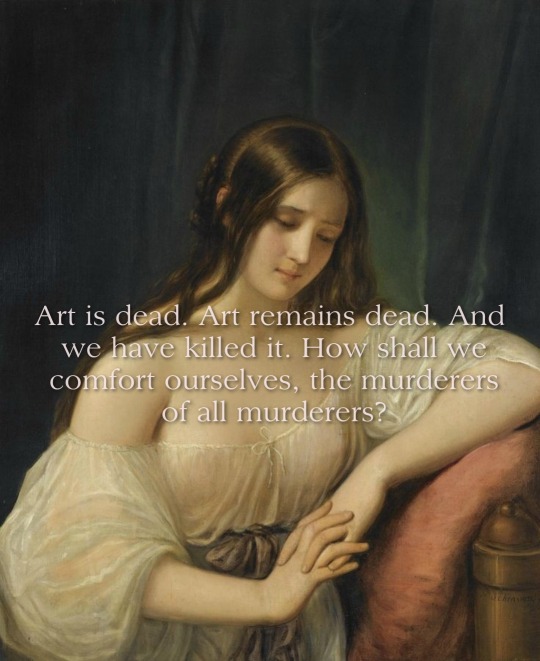
#art#girlblogger#coquette#gaslight gatekeep girlboss#lana del rey#whisper girl#the feminine urge#it girl#lily rose depp#girl blogger#manic pixie dream girl#dollette#kafkaesque#th1gh gap#girlblogging#female hysteria#philosophy#girl blogging#dior girl#art philosophy#nietzshe#hyper feminine#hyperfemininity
145 notes
·
View notes
Text
Creating 'Bad' Art
The reason you look at your art and feel such disgust and disappointment is because you know your potential. Delicacy and taste are a practiced sense that comes with time spent considering creation. Currently your taste is higher and more cultured than your ability which is why you feel able to cast judgement on other peoples work who are arguably more skilled than you.
But knowing you can't yet create that image you have in your head isn't a reason to never try. It's really the opposite. You need to create a thousand bad things to create your one good thing.
Lets say arts value comes from its impact. Bad art would be art that is unimpactful. Art that makes you feel nothing. You may be an elitist dick who hates modern art because it "takes not skill" and "I could've done that so what makes this circle on a blank canvas so special?". But that art make you feel an emotion, albeit anger, you still felt something at the hands of someone else. If your argument for why art is bad is that "you could've done it"... then why didn't you? You may feel something is bad because you feel you could've done it but you never did it. you never put yourself out there and made anything because you were too scared of making something someone found worthless. They did something. You did nothing.
"Make good work. Make interesting work. Make the work you want to see.' - My College Art Teacher.
Make bad art because god forbid you have a good idea and you lack the skills to make it real.
9 notes
·
View notes
Text
Book List: Aesthetics, Neuroaesthetics, & Philosophy of Art
Why Science Needs Art: From Historical to Modern Day Perspectives 1st Edition by Richard Roche (Author), Sean Commins (Author), Francesca Farina (Author)
Feeling Beauty: The Neuroscience of Aesthetic Experience by G. Gabrielle Starr (Author)
An Introduction to Neuroaesthetics: The Neuroscientific Approach to Aesthetic Experience, Artistic Creativity and Arts Appreciation 1st Edition by Jon O. Lauring (Editor)
Brain, Beauty, and Art: Essays Bringing Neuroaesthetics into Focus by Anjan Chatterjee (Editor), Eileen Cardilo (Editor)
Philosophy of Art: A Contemporary Introduction (Routledge Contemporary Introductions to Philosophy) by Noël Carroll (Author)
Philosophy of the Arts: An Introduction to Aesthetics 3rd Edition, by Gordon Graham (Author)
The Oxford Handbook of Aesthetics (Oxford Handbooks) Revised ed. Edition by Jerrold Levinson (Editor)
Aesthetics and the Philosophy of Art: The Analytic Tradition, An Anthology (Blackwell Philosophy Anthologies) 2nd Edition, by Peter Lamarque (Editor), Stein Haugom Olsen (Editor)
What Art Is by Arthur C. Danto (Author)
After the End of Art: Contemporary Art and the Pale of History - Updated Edition (Princeton Classics Book 10) by Arthur C. Danto (Author), Lydia Goehr (Foreword)
Ways of Seeing: Based on the BBC Television Series (Penguin Books for Art) by John Berger (Author)
Art and Its Significance: An Anthology of Aesthetic Theory, Third Edition 3rd Revised ed. Edition, by Stephen David Ross (Editor)
But Is It Art?: An Introduction to Art Theory by Cynthia Freeland (Author)
The Art Question by Nigel Warburton (Author)
Arguing About Art: Contemporary Philosophical Debates (Arguing About Philosophy) 3rd Edition by Alex Neill (Editor), Aaron Ridley (Editor)
Art Theory: A Very Short Introduction (Very Short Introductions) by Cynthia Freeland (Author)
Aesthetics: A Very Short Introduction (Very Short Introductions) Illustrated Edition, by Bence Nanay (Author)
The Cambridge Handbook of the Psychology of Aesthetics and the Arts (Cambridge Handbooks in Psychology) by Pablo P. L. Tinio (Editor), Jeffrey K. Smith (Editor)
Aesthetics: A Comprehensive Anthology (Blackwell Philosophy Anthologies) 2nd Edition, by Steven M. Cahn (Editor), Stephanie Ross (Editor), Sandra L. Shapshay (Editor)
Philosophies of Art and Beauty: Selected Readings in Aesthetics from Plato to Heidegger by Albert Hofstadter (Author, Editor), Richard Kuhns (Author, Editor)
Art, Aesthetics, and the Brain Illustrated Edition, by Joseph P. Huston (Editor), Marcos Nadal (Editor), Francisco Mora (Editor), Luigi F. Agnati (Editor), Camilo José Cela Conde (Editor)
#study guide#book list#neuroscience#neuroaesthetics#philosophy of art#art philosophy#dark academia#dark academia study guide
22 notes
·
View notes
Text
...I will say, I think a thing that the critics of AI art get wrong is that, a lot of them say that "They'll never be able to get a real illustration job using their fake-art" due to the medium's limitations, but in my experience, that's not what a lot of committed AI artists are doing.
Like, a lot of dabblers fit that paradigm to be sure, but like, the people who're committed to it are the ones I see combining it with other art skills, like photomanipulation or Programming Shenanigans or creative writing or video editing or so-on.
Like, I'd say that AI Art flourishes best as a part of multimedia art approaches, one new tool amongst the many multimedia artists use, and to treat it as just a competitor to traditional illustration is to ignore that...
16 notes
·
View notes
Text
insane long post art philosophy astrophotography ramble below \/
i like to think about how much of my work is actually noticed by the viewers. this is kind of an interesting thread to pull on because i do multiple types of art, and each has a different level of accessibility and behind the scenes quality to it (that being like, how much of the work you do behind the scenes is acknowledged by the viewers).
i'd say digital art is the most relatable to people (almost everyone has drawn something in their life; no, they may not understand the full depth of what *you* do as an experienced artist but they get the general idea and skill level necessary to do it), and therefore the most widely praised. you could make the same argument for photography but that's a whole can of worms with how photography has been hollowed of meaning/normalized to death with smartphones, i'd wager they relate more to a subject and that the art itself of photography is somewhat foreign to them.
pixelart is in a sense, a more unknowable version of digital art. most people have probably seen it before, but not done it; they might think they have a general idea of how it's made (it may be right, or it may not be). it's still relatable on a surface "this drawing is cool" level of course but there's a distinct divorce with the final product and the behind the scenes factor. this comes up a lot, in art forms with a more unknowable behind the scenes factor the divorce is larger and larger.
astrophotography is a whole different paradigm. you might think, like pixelart, it's just an extension niche of photography; it isn't. it shares some proverbial blood, and the key thing here is that the shared traits are all in the final product- not behind the scenes. outwardly, it looks quite similar to photography; it may even use the same equipment, and can sometimes achieve similar results to an untrained eye. but behind the scenes is a completely different process.
this divorce is insanely large, and since outward result isn't necessarily easily noticed as different or unique (from normal photography of the same subjects), it creates this weird reaction where people *think* they can relate to the entire thing totally (since typically people understand the basic mechanics of photography; using a camera, taking a picture, etc) even though what's happening behind the scenes is utterly alien to them.
since the result is similar enough to regular photography, instead the value of the art is moved from the final result to behind the scenes. which is odd, pixel clusters or brush strokes individually aren't the value of the art; they're a means to an end. yet with AP, the value *is* partially at least in the technical quality of the image- something the average viewer literally cannot and does not see or understand, for the most part.
this overall, makes the art form naturally resistant to public viewing/large scale publicity. it also tends to create an echo chamber type of environment where the only people that can fully understand and appreciate the art, are other artists. imagine if by and large, the public couldn't really relate to digital/traditional art. think about the impact that would have on like, everything. it's a weird situation for an art form to exist in.
#photography#astrophotography#art#pixelart#astrophotography thoughts#art thoughts#art philosophy#philosophy#long post
14 notes
·
View notes
Text
What the Fuck is Art?
Read it on Medium: https://medium.com/@stardustexpress/what-the-fuck-is-art-87b757fadb3

Here’s the thing, there’s no actual definition of what art truly is. Sure you can look up the dictionary definition and call it a day, but that’s boring. I want you to sit down and ponder about it with me.
Art is subjective. It can mean anything. To some it’s their passion, some would say it’s decoration, and to some it’s a waste of time and money.
During one of my gaming sessions where I would spend hours playing Genshin Impact, I decided to play Nilou’s story quest, To The Wise. I won’t say any major spoilers but the gist of it was the Zubayr Theater receives a notice that the theater will get demolished due to their constant violation of the Akademiya’s rules regarding the performances they put out. Throughout this quest, a particular NPC caught my attention, Khasani.
Khasani was previously an Akademiya scholar pursuing the mastery of art. However, he left this path because the more he pursued its mastery, and the more he became a connoisseur, the more estranged and lost he felt with what art truly is. At some point, he asks you and Nilou what you think the definition of art is and that led me to spiral down into this article.
Now if you were to ask how I define it, I’d say that art is both an escape, and a language.
Many artists refer to their craft as an escape from the burdens of everyday life. In this world full of problems, pressure, and burdens, art becomes a sanctuary. It is a way for you to vent out your emotions, letting yourself get lost in the process and forget about whatever it was that is bothering you.
Art reflects the beauties and horrors there is in life. It serves as an outlet where you can freely express yourself and your thoughts with no limits. It helps us communicate the things that are difficult to talk about, freeing us from the constraints of words and immersing ourselves with the language of color, shapes, and movements. There are no rules in this beautiful world, the only limit truly is your imagination.
Have you ever walked into a museum, an art gallery, or even scrolled through social media, and saw this artwork that just sucked you into a whole different dimension? Like the air was punched out of your lungs the moment you laid eyes to the piece. Or after finishing a good movie/series you feel transported back to the real world after being so immersed in that fictional world? That’s just one way of art serving as a literal, almost physical escape from the real world.
"Art doesn’t discriminate, and it appeals to all. Everyone has the right to appreciate art." -Nilou
Not to be that person who looks down on those who just like art for its visual appeal and aesthetic, albeit some of those people tend to look at art on a surface level and if it doesn’t fit their visual aesthetics, they consider it invaluable. That being said, I personally think that it takes a deeper level of comprehension to understand the true essence of a piece. To see beyond the colors and shapes takes a lot of understanding.
Understanding art is like learning a new language, its mediums are its dialects. With this in mind, asking an artist of a certain medium, like graphic design per se, to animate is like asking a person to speak a language they barely know. Sure they can speak it but it wouldn’t be as fluent and refined as someone who has dedicated their time and effort to study that language.
Just like languages, each medium has its own intricacies and technicalities. It takes a lot of effort to be fluent in one. Seeing people who think that we, artists, can do all mediums with ease is kind of insulting to those who have spent so much to master a medium. Seeing people who look down on artists, using the overused argument that everyone can draw, sew, paint, etc., making their craft seem insignificant, is infuriating.
Art is a language not everyone speaks. Humans tend to devalue and ostracize things they do not understand instead of doing the work to understand one thing better. This is one of the reasons why there is so much backlash against abstract art (i.e. Who’s Afraid of Red by Barnett Newman) and high fashion (Schiaparelli Spring-Summer 2023 couture collection, Inferno).
The thing is, art does not discriminate. People discriminate art just because it’s beyond their understanding.
"The meaning of art comes not from its creators, but from its audience.” - Khasani
Going back to Nilou’s quest, the story received so many negative comments from fans, and many players dislike Nilou because her story is “boring” or her existence in the game is simply for fanservice. People who failed to understand the meaning of the quest, nor Nilou’s existence in the game are the same people who look down on artists and the creative industry. The same people who demand creators to produce more quality work in so little time, yet refuse to pay for an artist’s services. Art is nothing in the eyes of an ignorant man.
At the end of the day, this is just my understanding or how I view art. How you define it is all on you. Life without art is devoid of meaning.
Art surrounds us. From the clothes we wear, the music we listen to, the shows we watch, the games we play, even the packaging of your favorite snack. Failing to see and acknowledge its value takes a lot of ignorance.
Now ask yourself. How do you define art?
#art philosophy#art#art community#art commentary#artists on tumblr#creative expression#creative writing#creative community#nilou#gi nilou
7 notes
·
View notes
Text
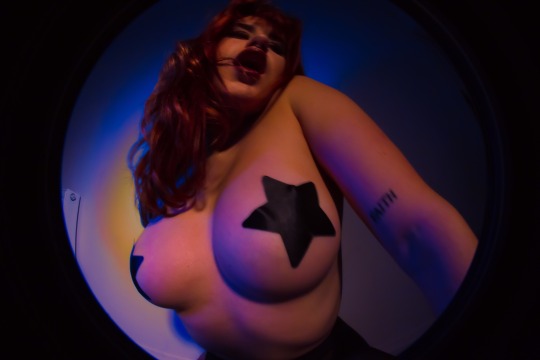
stargirl
#onlyf@nz#photography#onlyfanz#self portrait#accountant#only for u#aesthetic#spicy content#i sell premium#a e s t h e t i c#romantic#aestheitcs#fisheye#art#art philosophy#photoshoot#fisheye photography
17 notes
·
View notes
Text
just out of curiosity: how do you survive without validation?
this question is mostly aimed at artists here, but this can apply to anyone.
So to clarify: How do you keep going without giving up as an artist? how do you feel good about your art when no one online notices you for it?
I will go first. for me personally, I love the process of creating rather than the end product. I enjoy making silly things and drawing them no matter how ugly they look. sometimes i make something pretty.
it can be hard no one noticing something you worked hard on, but i have learned to love the act itself rather than the end product. learn to have fun with it.
anyone else relate? or maybe you have a different opinion? discuss!
#art#digital artist#artist#digital art#artist problems#artist struggles#artist on tumblr#artists on tumblr#art philosophy
10 notes
·
View notes
Quote
Art, from the beginning, endeavored to express emotions and historical facts to be understood by all human souls of all nations, without need of written words. Art uses the gestures of human beings, the atmosphere of the universe to convey thought and emotions and to record events. Without thought and emotions, it has no reason for existence.
Anna Lea Merritt
6 notes
·
View notes
Text
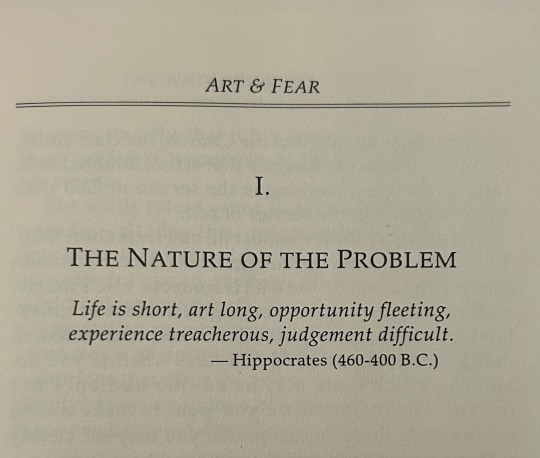
✨Art long
#Art & fear#art theory#art psychology#art philosophy#art academia#abide forever#art struggles#artist life#artist problems#hippocrates
8 notes
·
View notes
Text
why is it when i make art i only wish to convey pain in convoluted ways? the horrors that lurk in my mind, why must they be my medium? do i wish to be heard? understood in a way so special to me? am i even special? why do i deserve my feeling to be set on a canvas for decades?
do others feel the same? are we all just trying to find ways to be heard? understood?
i wish my art was beautiful, so maybe others could enjoy it, rather than hear me, or understand me. why must they empathize with me?
in writing this i find i want people to be in ignorant bliss of the world i live in.
how does one turn pain into beauty with the stroke of a brush? perhaps its their eyes or the flick of their wrist? maybe they're just kind?
2 notes
·
View notes
Text
This Is Not Real: Artpunk as an Inorganic Movement
To cut to the chase: Artpunk is not currently “real.” It does not exist. Save your time and your searches, set your pickaxe aside and do not begin digging quite yet. There is no prior context to be discovered, no research to be conducted, No searches that will bring you answers. Not in any sense that would actually explain to you what we mean when we say “Artpunk.”
There are independent points of reference that can be used to understand Artpunk’s potential place in the Art sphere. There is Art Punk, from whom the name is derived (or wholesale stolen), and Post-Punk, from whom many of Artpunk’s musical characteristics are derived. There is Experimental Art and Music, which inform the ephemeral nature of Artpunk as a genre and aesthetic. There is DIY Arts culture, which inspires Artpunk to directly adopt the DIY ethos. There is Cyberpunk, whose naming convention and use of the -punk suffix inspires the naming conventions of Artpunk. There is Dada and Surrealism, experimental movements that show us how the Artists that came before us tried to push beyond, and what they found on the other side.
However, Artpunk itself does not yet have a backlog to dive into. There are no true points of reference. It just doesn’t really exist, not by this new definition and approach, anyways. As such, all discussion about Artpunk from here on out are to be considered speculative and, admittedly, revisionist. At time of writing, it doesn’t exist outside of loose ideas passed between collaborators and a manifesto (written by myself, full disclosure). It’s more underground than underground. There is no existing and organic narrative that supports the existence of Artpunk. We must take the ones that we do have and bend them, twisting and shaping them until they tell a new story, one that encourages Art for the sake of the Artist and the use of Art as a tool to re-shape reality against it’s own trappings.
When we make reference to artists who are not purposefully engaged in Artpunk, we are using their Artistry as a means of developing a sort of “negative image” of the aesthetic. We find out what it is, and what It can be, by finding its evolutionary similarities to other forms of Art. By sticking our flag where it doesn’t belong, we incorporate these shared similarities to form a broken family tree, a lineage that we can point to and say: “That is where I come from. Can you see it?”
This isn’t condemning. This isn’t a shame we must carry. This is a gift. Because there is no standard for Artpunk, we may shape its look and feel. We can consciously create a sense of unity, bound together through an undying love and devotion for Art, sharpened to a blade by our jaded nature, and turn it against a world of cheap imitation and pointless luxury. The rebellion of the Arts may take whatever form you choose, whichever shape you see fit. All your creations are worthy of the title. All that fits outside and in-between. Build the Artpunk that you think should exist. There is no way you can do it wrong, because nobody’s doing it. This is not real. We have to make it first.
26 notes
·
View notes
Text
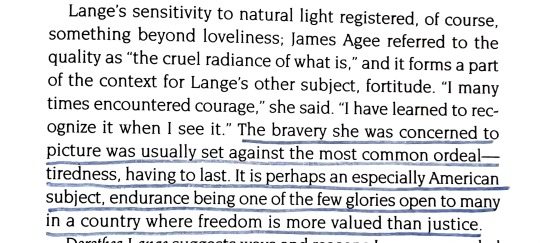
From Why People Photograph by Robert Adams, 1994
#having a lot of Thoughts about this#and hustle culture#and Americans finding identity in working rather than being#robert adams#dorothea lange#photography#art#art philosophy#art history#photo history#history of photography#America#united states#American culture#hustle culture#why people photograph
4 notes
·
View notes
Text
Well, thinking about the AI art issue (Yes, it's been occupying my thoughts a lot), I think one part of the rhetorical gap is that a lot of folks against it are coming from a working-class commercial art perspective, and a lot of folks from the AI-art-as-actual-art perspective are coming from a conceptual/"high" art persepctive.
And the thing to note is that people in the former fucking hate people in the latter. And not for totally unwarranted reasons!
Like, there's a good reason comic fans have an unmitigated loathing for Roy Lichtenstein or the fact that "pop artists" can infringe as much as they want while small artists constantly have to fear the copyright hammer.
hell, I've stated my issues with conceptual art in terms of its class gating, IE "Why does the dipshit taping a banana to a wall get 6 figures while my friends struggle" and so-on.
And I bring it up because I think anyone making arguments in favor of AI art from an artistic perspective; and again using arguments drawn from the conceptual/abstract art world; needs to grapple with that legacy of conceptual art's shittiness towards working/commerical artists and actually try to build bridges.
Like, friend of the blog @tangibletechnomancy said it best (quoted with their permission)
Like, on the class issue with fine art vs. commercial art is something that I have a LOT of feelings about because both sides often have good points about the other's shortcomings but then overshoot the mark into blatant classism in the fine art sphere or anti-intellectualism in the commercial art sphere
Like, it's not a lie that fine art is very often financially gatekept, there can be a fucked up ouroboros of elitism where your name and background is what makes you sell, but "oh my kid could have made that!" isn't an argument because...did they?
In fact, could they have actually? is the point of the piece the distant appearance of the finished product, or is it the technique, or the statement the artist was trying to make?
Yeah any kid could absolutely paint colored squares, but could they do it in such a way as to make acrylic paint smoother than machine-applied vinyl? A kid could sign a urinal, but could they present it as a question on what defines art and defend it like a thesis?
But on the other side it's very true that things like video game art and book cover illustration and so forth, the artisan illustration side, has a tendency to get very shut off and copyright troll-y and lose touch with why people make ANY other kind of art
There's this demand to conflate the personal and the professional, and so much of this happens at the expense of art as a tool for human enrichment, but then so much of that discourse spirals into "ugh, idiots, why don't you just ask the rich parents you definitely have to pay your bills? Damned sellouts" which is NOT HELPING ANYONE
And I think they have a good point!
26 notes
·
View notes
Text
Book 42: Art Matters
Back to the RNG and it popped up 701: Philosophy and theory of fine and decorative art. Bright Earth: Art and the Invention of Color by Philip Ball looked brilliant, but it only has an ebook version in Spanish, so that was a no-go. So I went with Neil Gaiman's Art Matters: Because your imagination can change the world.
It's a set of a few essays by the renowned author, the first exhorting people to read fiction, support libraries, and encouraging children to read (what they want, not what you want them to). Very much propaganda, and commissioned as such by a library organization, but it's for a good cause- reading and libraries- so it's ok. He admits it's in his self-interest as an author to promote such things, but he says he's more enthusiastic to do so as a reader. (Yeah, right, Neil, we're onto you! After all....)

The other major essay was one encouraging people to make good art. Called, surprisingly, "Make Good Art". I think the message is all well and good, but telling people to make good art- to reference the Simpsons again- is like Mr. Burns telling Daryl Strawberry to hit a home run as "good" coaching. It's easy to say to make something good, but a lot harder to actually accomplish it. I think a better message is to encourage people to just make art. Good art will come and bad art will come and not everyone will agree on which is which.
Incidentally I borrowed both the audio book and the ebook of Art Matters. I'm glad I got both because the ebook is gorgeously illustrated by Chris Riddell. But it's also a fustercluck of some kind of handwriting font that my feeble ADD brain couldn't stick to, so getting the words through the audio book first helped an awful lot.
SHOULD YOU READ THIS BOOK:
Sure, it's short, insightful, and very beautifully drawn.
ART PROJECT:
So, I made art of Neil Gaiman. He suggests making your own art and not copying other people's. Which is too bad, because I generally try to match the style of the illustrated books. So I compromised and did partially my style a little sketchy like the book's illustrations. Is this the good art Gaiman said to make? I don't know, but it is art, and I think that's what's important.

#neil gaiman#art matters#52booksproject#52books#dewey decimal system#rng#random number generator#art philosophy
4 notes
·
View notes